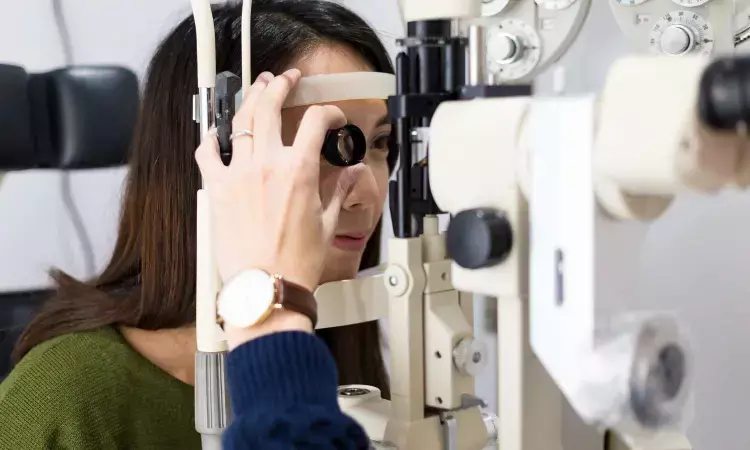- Home
- Medical news & Guidelines
- Anesthesiology
- Cardiology and CTVS
- Critical Care
- Dentistry
- Dermatology
- Diabetes and Endocrinology
- ENT
- Gastroenterology
- Medicine
- Nephrology
- Neurology
- Obstretics-Gynaecology
- Oncology
- Ophthalmology
- Orthopaedics
- Pediatrics-Neonatology
- Psychiatry
- Pulmonology
- Radiology
- Surgery
- Urology
- Laboratory Medicine
- Diet
- Nursing
- Paramedical
- Physiotherapy
- Health news
- Fact Check
- Bone Health Fact Check
- Brain Health Fact Check
- Cancer Related Fact Check
- Child Care Fact Check
- Dental and oral health fact check
- Diabetes and metabolic health fact check
- Diet and Nutrition Fact Check
- Eye and ENT Care Fact Check
- Fitness fact check
- Gut health fact check
- Heart health fact check
- Kidney health fact check
- Medical education fact check
- Men's health fact check
- Respiratory fact check
- Skin and hair care fact check
- Vaccine and Immunization fact check
- Women's health fact check
- AYUSH
- State News
- Andaman and Nicobar Islands
- Andhra Pradesh
- Arunachal Pradesh
- Assam
- Bihar
- Chandigarh
- Chattisgarh
- Dadra and Nagar Haveli
- Daman and Diu
- Delhi
- Goa
- Gujarat
- Haryana
- Himachal Pradesh
- Jammu & Kashmir
- Jharkhand
- Karnataka
- Kerala
- Ladakh
- Lakshadweep
- Madhya Pradesh
- Maharashtra
- Manipur
- Meghalaya
- Mizoram
- Nagaland
- Odisha
- Puducherry
- Punjab
- Rajasthan
- Sikkim
- Tamil Nadu
- Telangana
- Tripura
- Uttar Pradesh
- Uttrakhand
- West Bengal
- Medical Education
- Industry
Faricimab therapy closely associated with severe intraocular inflammation, reveals research

A new study published in the Journal of American Medical Association showed that rare instances of noninfectious intraocular inflammation may be linked to faricimab (Vabysmo) intravitreal injections.
The US Food and Drug Administration has approved faricimab, a humanized, biospecific immunoglobulin G (IgG) monoclonal antibody, for use as an intravitreal injection (IVI) to treat neovascular age-related macular degeneration (AMD), diabetic macular edema (DME), and macular edema caused by retinal vein occlusion. This medicinal compound is intended to improve vascular stability by inhibiting neovascularisation and hyperpermeability by targeting the vascular endothelial growth factor A (VEGF-A) and angiopoietin 2 pathways.
Clinical studies using randomization were used to prove the safety and effectiveness of drugs. Even if causality cannot be established, evidence of adverse events linked to these medications in a clinical practice context can be helpful in developing theories about less frequent safety concerns. Thereby, Mariano Cozzi and colleagues thus carried out this investigation to report and examine instances of intraocular inflammation linked to faricimab treatment in patients who were sent to a solitary European facility.
This review of an observational case series began in April 2024. The patients came from a single Swiss tertiary referral center that was academically orientated. The patients who were referred for intraocular inflammation shortly after getting an intravitreal injection of faricimab between June 1, 2022, and March 5, 2024 were included in the study. Faricimab, 6 mg was used for diabetic macular edema or neovascular age-related macular degeneration (0.05 mL of a 120 mg/mL solution).
In this study, 12 eyes from 7 individuals over a 22-month period were found to have noninfectious intraocular inflammation following intravitreal faricimab injections. In two of these instances, anterior and posterior inflammation coexisted with retinal vasculitis. An occlusive type of artery and vein vasculitis affected one of the two eyes which resulted in nonperfusion of the macular capillaries and a clinically significant permanent decline in vision from 20/80 to 20/2000.
Moderate anterior segment inflammation without significant alterations in vision was observed in the remaining eyes. The incident of intraocular inflammation transpired following a median of 3.5 injections of faricimab. The diagnosis of inflammation was made 28 days after the previous faricimab dose. 3 individuals experienced an elevated intraocular pressure of at least 30 mm Hg. Overall, these findings highlight the significance of continuing monitoring for possibly sight-threatening intraocular inflammation following intravitreal faricimab treatment.
Reference:
Cozzi, M., Ziegler, A., Fasler, K., Muth, D. R., Blaser, F., & Zweifel, S. A. (2024). Sterile Intraocular Inflammation Associated With Faricimab. In JAMA Ophthalmology. American Medical Association (AMA). https://doi.org/10.1001/jamaophthalmol.2024.3828
Neuroscience Masters graduate
Jacinthlyn Sylvia, a Neuroscience Master's graduate from Chennai has worked extensively in deciphering the neurobiology of cognition and motor control in aging. She also has spread-out exposure to Neurosurgery from her Bachelor’s. She is currently involved in active Neuro-Oncology research. She is an upcoming neuroscientist with a fiery passion for writing. Her news cover at Medical Dialogues feature recent discoveries and updates from the healthcare and biomedical research fields. She can be reached at editorial@medicaldialogues.in
Dr Kamal Kant Kohli-MBBS, DTCD- a chest specialist with more than 30 years of practice and a flair for writing clinical articles, Dr Kamal Kant Kohli joined Medical Dialogues as a Chief Editor of Medical News. Besides writing articles, as an editor, he proofreads and verifies all the medical content published on Medical Dialogues including those coming from journals, studies,medical conferences,guidelines etc. Email: drkohli@medicaldialogues.in. Contact no. 011-43720751


